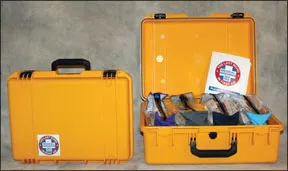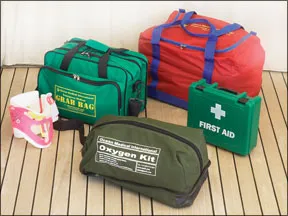In Practical Sailor’s ongoing test series on seagoing medical kits, the search now leads to what we regard as Group III medical kits, those kits designed for sailors who might not have access to a hospital or trained medical personnel for up to 24 hours. These kits should contain equipment and medicines capable of sustaining badly injured crew beyond the first-aid stage.

Photo by Oskar Kihlborg/Volvo Ocean Race 2005-2006
This is the first category in our series in which both the caregiving skills and the medical kit must be upgraded significantly beyond the scope of Group I (Practical Sailor April 2008) and Group II (Practical Sailor June 2008). (See the “How We Tested” description for details regarding each group.)
The kits in Group III stock more of the items mentioned in our first two articles and will contain, for the first time, items that enable a trained caregiver on board to monitor a sick or injured patient while seeking the advice of professionals via electronic communication. We set a target price of $500 for this type of kit.
Risk Assessment
The kits we evaluated in groups I and II were appropriate for short-distance sailing and essentially meet the requirements of basic first aid. However, when professional medical assistance could be up to 24 hours away, a sick or injured crewmember may require more definitive care. In these situations, it may be necessary to splint broken bones, cleanse and suture lacerations, alleviate pain or administer fluid therapy, all of which demand additional medicines and medical materials beyond the scope of group I or II kits.
Additionally, the books/medical manuals become more important guides for treating patients and for communicating with medical personnel ashore should that be necessary.
One word about communications: While a VHF radio is always recommended on any boat, communications become more vital on vessels in the Group III category. Whenever a boat moves beyond 25 miles from a land base, long-range communications via satellite phone or single-sideband radio become an important consideration. The viability of these kits depends greatly on the ability to reach medical services or arrange for a medical evacuation within 24 hours. Vessels in Group III could include those fishing far offshore, sailors traveling to more distant landfalls, or those cruising to remote regions.
Adventure Medical Marine 2000
The Marine 2000 from Adventure Medical exceeds our Group III standards in its variety of components, and includes items that pertain especially to those on a boat in this category, such as a dental kit, stethoscope, ear antibiotics, and treatment for jellyfish stings. Among the additional medicines it contains are water-resistant sunscreen (SPF 30), cough syrup, nasal spray, and insect repellent. It is also supplied with A Comprehensive Guide to Marine Medicine by Dr. Eric Weiss and Dr. Michael Jacobs.

The seven modules that make up this kit (CPR/Instruments; Medications; Wound Care; Burn/Blister; Fracture/Sprain; Dental/Suture/Syringe; and Bleeding) are arranged neatly and are easy to identify with clear vinyl windows and large labels as well as color coding.
The padded nylon container, which opens by way of a zipper, is buoyant when closed, and shock- and water-resistant. It also has reflective bands sewn around it for easier identification at night or in low-light circumstances like a capsized vessel.
With a street price of $499 (www.defender.com), the Marine 2000 is a bit more expensive than its nearest competitor from Fieldtex—the Coastal Cruising Pak, but meets our imposed budget.
Bottom line: This kit outscored the others in quality and arrangement of contents, and lacked only a bag of sterile fluid and a razor relative to our Group III standards. It ranks as Practical Sailor’s Best Choice in this comparison.
Fieldtex Coastal Cruising Pak
Fieldtex offers two versions of its Coastal Cruising Pak, one in a soft case and one in a hard, watertight case. We evaluated the latter. This company does not supply much in the way of medicine in its kits, and for the first time in our evaluations, this poses a problem. Because of the nature of afflictions that might arise in the use of Group III kits, medications are definitely essential, and this kit requires that the user add his own. (The kit does contain aspirin, antacid tablets, iodine, burn gel, calamine lotion, eyewash solution, hydrogen peroxide, and antibacterial ointment.) Of course, you could easily fill in these gaps on your own, but that defeats the point of opting for a kit—to save buyers the agony of contemplating the mind-numbing array of over-the-counter medications at the local pharmacy. However, for those who prefer to stock their own brand medications, this kit makes it easy to do so.
The contents of the Coastal Cruising Pak are separated into eight modules for ease of identification and implementation, including one for user-supplied medications. It also comes with a color-coded, waterproof manual: “First Aid by the Numbers.”
Among our Group III test specimens, the Coastal Cruising Pak was stocked the lightest, primarily due its lack of medications. However, the injection-molded, watertight case is a major asset. The rugged box won’t deteriorate for a long, long time, and it provided the best shock and water resistance for its contents among the three kits we evaluated. It’s also readily identifiable as a medical kit due to its bright yellow color. And, at $449, the Fieldtex Coastal Cruising Pak falls within the budgets of most sailboat owners, especially those willing to supply more of their own medications.
Bottom line: This kit offers the best container with easily identifiable contents. It also falls within our $500 budget. Though a step below the Adventure Medical Kit in its range of contents, it is a fine choice for those who have the time and patience to stock their own medications.
OMI Class B Kit
The Class B Kit from Ocean Medicine International supplies the most items among our three contenders, enabling the treatment of the widest range of disorders, and these materials are all of high quality. The kit, which is designed to serve up to 10 crew, is actually made up of several subsections. The Grab Bag, which we evaluated in Group II, is supplemented with a second, larger duffel-type bag containing smaller kits, including a full oxygen kit and a first-aid kit in a hard, waterproof container. The Grab Bag is sturdy, but the duffle is flimsy and offers little cushioning to its contents and only partial water resistance.
We did like that the rest of the contents are well organized in modules, which each – have instruction labels on their storage pouches and the medicine containers. Our tester—Dr. Ed Mapes—noted that the kit contains apparatus for conditions such as transient stroke, convulsion, and psychiatric disturbance.

The kit compares favorably with the group standards in terms of its contents, but the cost is far more—$4,840—and far exceeds our $500 budget in this category. According to OMI, the higher price is due in large part to the number of prescription medicines included in the kit, and that it is designed to meet or exceed MCA/STCW 95 requirements (standards established by the United Kingdom’s Maritime and Coast Guard Agency and the International Maritime Organizations Standards of Training, Certification, and Watchkeeping.)
Admittedly an apple among oranges, this kit was included because its contents are comparable to the other Group III kits. Its marketing materials identify this kit as suitable for those “travelling up to 150 nm offshore and/or 12-24 hours from medical care.” We should also note that OMI offers smaller kits as well as a 24/7 medical consultation program for mariners, but that comes at an additional fee.
Bottom line: This is a well-stocked, well-organized kit with very good instructional material, but there are more economical options in this group.
Conclusions
Each of the kits we examined in Group III contains the majority of items listed among our Group III standards. And for the most part, they each address the need for more contents, both in quantity and variety compared with previous kits. There is, however, substantial disparity between the kits in this group, calling for more judgment in terms of selection on behalf of the buyer.
Distinct differences in the companies’ philosophies are also emerging in these larger, more expensive kits. This category represents the first one for which the buyer should prepare a list of supplies and medications that most reflect his or her needs as a basis of comparison. Once that baseline has been addressed, other factors such as packaging, convenience, pricing, and other services offered by the companies can be taken into account. It is important for readers considering a medical kit to develop their own group standards and compare what these three kits offer against their crew’s specific needs. Don’t select a kit without using this forethought; you might easily end up with a kit that oversupplies your vessel or find yourself lacking elements that truly are necessary for your crew.
The Class B Kit and the Marine 2000 performed very well against our Group III standards and actually exceeded those requirements in some areas. On that basis, they would both be acceptable as kits on board Group III vessels. The components of all three kits were deemed to be of very good quality. Inasmuch as cost and perceived value are parameters in this study, the Class B Kit from Ocean Medical International costs many times the price of the other kits. This is partly due to the dollar’s declining value against the euro (this kit is manufactured in England), but nearly $5,000 is still a surprisingly high price to pay for a medical kit, even with its longer list of medications.
The judging is somewhat closer between Fieldtex’s Coastal Cruising Pak and Adventure Medical’s Marine 2000. An examination of the scores compared to the group standards reveals an advantage for the 2000.
The hard case of the Coastal Cruising Pak offers superior content protection, and sells for less than the Marine 2000. Those who don’t mind procuring their own medications and supplementing the kit with items such as a suture, a thermometer, syringes, blood pressure cuff, etc., should choose the Fieldtex product. However, when all factors are considered, the Adventure Medical product is Practical Sailor’s Best Choice in Group III. It combines a wide variety of high-quality components, top-notch instructions, and excellent packaging with a reasonable price. In addition, the Marine 2000 reflects a more thorough understanding of what sailors need. We get the impression that there’s an old sailor at the helm of Adventure Medical, making choices for the medications and supplies that we really need offshore.




































